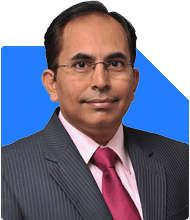Ramalingam Kalirajan |10893 Answers |Ask -Follow
Mutual Funds, Financial Planning Expert - Answered on May 03, 2024
He has an MBA in finance from the University of Madras and is a certified financial planner.
He is the director and chief financial planner at Holistic Investment, a Chennai-based firm that offers financial planning and wealth management advice.... more

Hi I'm investing 1500 in nifty mid cap 150 index, 1000 in nifty next 50 index and 500 in nifty 50 index. 100 percent passive investment fpr long term. Any suggestions with allocation or diversification?
Current Portfolio:
Nifty Midcap 150 Index (1500): This is a good way to gain exposure to mid-sized companies in India.
Nifty Next 50 Index (1000): This provides exposure to companies on the cusp of joining the Nifty 50, potentially offering higher growth.
Nifty 50 Index (500): This offers diversification with large, established companies.
Overall, your portfolio is leaning towards a growth strategy with a good focus on mid-cap and small-cap companies. This has the potential for higher returns but also comes with higher risk.
Active vs. Passive Investing:
Active Funds: These are managed by professionals who try to outperform the market by picking winning stocks. While active management can be successful, studies show that over the long term, a large percentage of actively managed funds underperform their benchmark index. The fees associated with active management also eat into returns.
Passive Funds (Index Funds): These track a market index, like the Nifty 50. They offer lower fees and historically, tend to match or outperform a significant portion of actively managed funds. This makes them a good option for long-term investors who don't want to spend a lot of time managing their portfolio.
Here's why your current approach with index funds is a good strategy for long-term investing:
Low Cost: Index funds have minimal fees, allowing you to keep more of your returns.
Diversification: You're already diversified across different market segments, reducing risk.
Long-Term Focus: With a long-term outlook, riding out market fluctuations is easier, and index funds tend to perform well over time.
Here are some additional thoughts:
Asset Allocation: Consider your risk tolerance and investment goals. You could adjust your weightings between the Nifty 50, Next 50, and Midcap 150 to achieve your desired risk profile.
Rebalancing: Periodically rebalance your portfolio to maintain your target asset allocation.
Ultimately, the decision of active vs. passive is yours. However, for a long-term investor with a focus on low costs and diversification, a passive approach with index funds is a well-supported strategy.
Lastly, if you're open to exploring active funds, consider consulting with a professional Mutual Fund Distributor (MFD) with Certified Financial Planner (CFP) credentials. They can provide personalized advice and recommend active funds that have the potential to outperform their respective indices over time.
You may like to see similar questions and answers below
Ramalingam Kalirajan |10893 Answers |Ask -Follow
Mutual Funds, Financial Planning Expert - Answered on May 29, 2024
Ramalingam Kalirajan |10893 Answers |Ask -Follow
Mutual Funds, Financial Planning Expert - Answered on Jun 25, 2024
Ramalingam Kalirajan |10893 Answers |Ask -Follow
Mutual Funds, Financial Planning Expert - Answered on Jul 18, 2024
Janak Patel |71 Answers |Ask -Follow
MF, PF Expert - Answered on Jul 15, 2025
Ramalingam Kalirajan |10893 Answers |Ask -Follow
Mutual Funds, Financial Planning Expert - Answered on Dec 15, 2025
Ramalingam Kalirajan |10893 Answers |Ask -Follow
Mutual Funds, Financial Planning Expert - Answered on Dec 15, 2025
Radheshyam Zanwar |6746 Answers |Ask -Follow
MHT-CET, IIT-JEE, NEET-UG Expert - Answered on Dec 15, 2025
Ramalingam Kalirajan |10893 Answers |Ask -Follow
Mutual Funds, Financial Planning Expert - Answered on Dec 15, 2025
Ramalingam Kalirajan |10893 Answers |Ask -Follow
Mutual Funds, Financial Planning Expert - Answered on Dec 15, 2025
Ramalingam Kalirajan |10893 Answers |Ask -Follow
Mutual Funds, Financial Planning Expert - Answered on Dec 15, 2025
Samraat Jadhav |2508 Answers |Ask -Follow
Stock Market Expert - Answered on Dec 15, 2025
Ramalingam Kalirajan |10893 Answers |Ask -Follow
Mutual Funds, Financial Planning Expert - Answered on Dec 15, 2025
Reetika Sharma |425 Answers |Ask -Follow
Financial Planner, MF and Insurance Expert - Answered on Dec 15, 2025
Radheshyam Zanwar |6746 Answers |Ask -Follow
MHT-CET, IIT-JEE, NEET-UG Expert - Answered on Dec 15, 2025









.jpg)
















